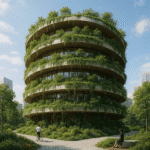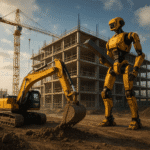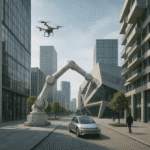The architectural frontier of a post-human era demands a radical rethinking of form, function, and the very essence of habitable space. In this exploration, futuristic structures merge with living systems, creating biomimetic frameworks that blur the boundary between the organic and the engineered. Beyond mere shelters, these edifices become dynamic partners in survival, adapting to shifting climates, evolving social paradigms, and the unknown challenges of interplanetary colonization. The following analysis delves into three critical domains—environmental integration, technological synthesis, and socio-cultural transcendence—illustrating how tomorrow’s architects might design for worlds where humans are no longer the sole drivers of innovation.
Environmental Integration
Designing for a post-human world places environmental symbiosis at the forefront. Buildings must metamorphose into living organisms, harnessing natural cycles rather than overpowering them. The shift toward sustainable megastructures entails deep collaboration with ecological processes, fostering resilience and self-regulation.
Living Façades and Biofabrication
Walls embedded with algae panels, fungal mycelium networks, or genetically engineered mosses transform façades into active filters. These biohybrid skins perform multiple roles:
- Oxygen generation and carbon sequestration via adaptive photosynthetic layers
- Thermal regulation through phase-change materials derived from living cells
- Self-healing capabilities enabled by bioresin secretion and microbial repair
Such façades evolve in real time, responding to air quality, humidity, and solar exposure. The result is a structure that breathes, grows, and refines itself with minimal maintenance.
Climate-Responsive Morphologies
Advanced environmental modeling predicts microclimate zones within each structure. By integrating shape-memory alloys and nanotechnology coatings, walls and roofs can shift geometry to optimize daylighting, ventilation, and shading. Examples include:
- Retractable canopies that extend during heat waves to provide passive cooling
- Dynamic louver systems that channel seasonal breezes into communal atria
- Folding membranes that trap solar heat in colder months and reflect it in warmer ones
These resilient forms ensure occupants experience optimal comfort with minimal energy expenditure.
Technological Synthesis
The fusion of cutting-edge technologies with architectural design paves the way for structures that anticipate, learn, and transform. In a realm where artificial intelligence and robotics are ubiquitous, buildings become AI-driven ecosystems.
Robotic Construction and Self-Assembly
Autonomous drones and ground-based robots collaborate to assemble modules on-demand. Prefabricated units, infused with magnetic joints and smart connectors, click together like building blocks. Key advantages include:
- Rapid deployment in remote or hazardous locations
- Reconfigurability, allowing floor plans to mutate according to functional needs
- Reduction of construction waste through precise additive manufacturing
By leveraging autonomous drones, these systems can also perform routine inspections, maintenance, and upgrades without human intervention.
Embedded Cybernetic Networks
Beneath every surface lies a web of sensors, actuators, and processors. This cybernetic infrastructure monitors structural integrity, human occupancy, and environmental conditions. Through distributed edge computing, local units make split-second decisions to adjust lighting, acoustics, and spatial configurations, fostering a truly responsive habitat.
- Adaptive acoustics that dampen or amplify sound based on occupancy patterns
- Personalized climate zones that track individual preferences through biometric feedback
- Real-time health diagnostics detecting pathogens or toxins and isolating affected zones
Energy Harvesting and Distribution
Next-generation power grids embedded within the built environment harness solar, geothermal, and kinetic sources. Transparent photovoltaic glazing and piezoelectric floor tiles transform surfaces into energy harvesters. Energy storage solutions integrate organic batteries made from algae-derived compounds, ensuring a sustainable and decentralized power network.
Socio-Cultural Transcendence
Inhabitants of the post-human epoch will inhabit spaces that reflect collective aspirations, ethical values, and the interplay of diverse intelligences—human, machine, and beyond. Architecture evolves into a medium for cultural expression and interspecies dialogue.
Symbiotic Community Hubs
Urban centers are reconceived as fluid assemblages of micro-environments. Pods of varying scales cluster around communal cores, fostering transcendent interactions. Community hubs may include:
- Shared bio-labs where citizens co-create new strains of living materials
- Cultural ateliers for immersive art forms blending augmented reality and neural feedback
- Experimental kitchens where synthetic foods are cultured on-site using 3D bioprinters
This model nurtures a sense of stewardship and collective innovation, reinforcing bonds across biological and artificial entities.
Terraforming and Off-World Habitats
Beyond Earth, designers confront starkly different climates and gravity regimes. Space habitats employ rotating cylinders or inflatables coated with micrometeorite-resistant membranes. Interiors are layered with hydroponic gardens, providing both food and psychological comfort. Key design principles include:
- Gravity modulation through centrifugal force in toroidal structures
- Radiation shielding using regolith-based composites
- Modular expansion strategies for gradual colony growth
The act of building in alien environments becomes an exercise in terraforming at both micro and macro scales, blending architectural ingenuity with planetary engineering.
Ethical Frameworks and AI Governance
As buildings gain agency, ethical considerations become paramount. Architectures of control must embed transparent AI governance, ensuring that decision-making algorithms respect autonomy, privacy, and environmental justice. Proposals include:
- Open-source AI protocols auditable by global communities
- Decentralized consensus systems for approving major structural adaptations
- Fail-safe architectures that revert to human oversight under critical conditions
These measures safeguard against unintended consequences, ensuring that synthetic intelligences serve the collective good rather than dictating terms.
In a world where the lines between the biological, mechanical, and digital realms are increasingly blurred, architects must embrace multidimensional thinking. The challenges of climate change, resource scarcity, and social fragmentation demand radical solutions—ones that push the boundaries of what buildings can be. By weaving together biomimetic systems, autonomous technologies, and inclusive cultural frameworks, the architecture of the future will not merely house humanity; it will coevolve with it, charting a path toward an expansive post-human horizon.










